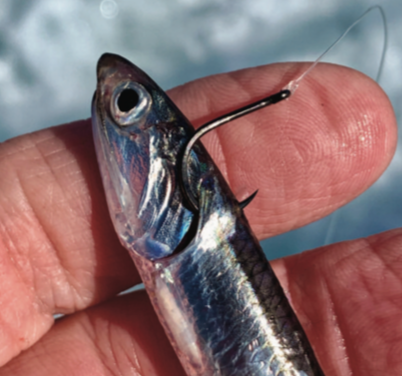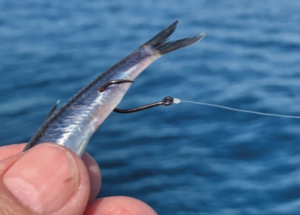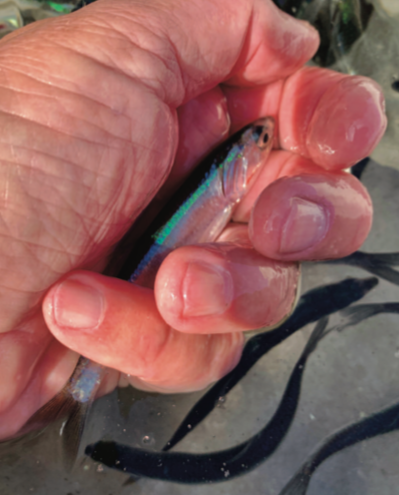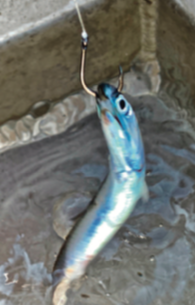
BY JON DICKENS
The guy with the scale-covered hat and bloodstained deck boots carefully selects his sardine from the bait well, gently hooks the bait and effortlessly casts it out a country mile. Ten seconds later he yells, “Ahhh, I’m bit!!!”
The seasoned pro is on yet another fish. Three in a row! What’s he doing differently than everyone else?
This scene has played out on local sportfishing boats thousands of times. To those in the know, it’s no big deal. But to those unable to hook that tuna, yellowtail or bass, it’s utterly frustrating. Why do a handful of anglers seem to catch fish relatively easily, while most stand at the rail and watch? Obviously, there are many factors that come into play, but one of the biggest has to do with how they select and hook their live bait.
Unlike other coastal regions, SoCal anglers are fortunate to have access to live bait thanks to the work-all-night bait haulers that serve the industry. Depending upon season and baitfish cycles, sardines, anchovies or squid are likely to show up in harbor bait receivers, so you don’t have to catch your own bait. Thank you boys!
While some anglers are dedicated jig slingers or plastic throwers, the vast majority fish with live sardines or anchovies for sur- face fish, and fly-line their bait – casting the hooked bait out as far as possible with no weight, and then fishing with the reel in free spool so it swims out naturally. Here’s a look at the basics of live bait fishing, and a few tricks that you may not have tried.
The two biggest mistakes anglers make
And the award for the two biggest mistakes the average angler makes while live bait fishing goes to: those not carefully selecting the right live bait, and not changing it often enough. While deckhands and captains are constantly chanting, “Change your baits!” you’ll rarely hear them say, “Take your time and pick a hot bait.” That should be added to their mantra.
At any given moment, a look into the bait tank’s hand wells may show weak, struggling sardines or anchovies mixed in with baits moving so fast they seem impossible to catch. The dilemma becomes, how much time do you spend searching for and catching the right bait? If you stand at the tank on a crowded boat for too long, other anglers may get annoyed because they can’t grab a bait, plus if the yellows just charged the boat, you want to get a bait in the water fast! That’s when anglers tend to grab whatever they can instead of searching for that primo bait. Oftentimes, that’s a mistake.
First and foremost is knowing what to look for. Avoid struggling baits or those with red noses and missing scales. They might as well be holding up little signs that say, “Don’t pick me, I won’t get bit.” Instead, look for the slippery dev- ils that avoid your outstretched hand and are the hardest to catch.
Whether there are sardines or anchovies in the well, pay attention to the “blondes” or “greenies” – the ones with the lighter-colored greenbacks. They tend to swim best. Cup your hand underneath your target bait and lift up or corral it in the corner of the well. Be gentle. Don’t squeeze the life out of the bait when grabbing it.
Five ways to hook your live bait

Once you’ve selected your bait, step away from the bait tank to let others in and hook it before you get to the rail of the boat to cast. Whatever method you choose, you want to hook it as quickly as possible and then hold the line just above the hook, instead of the bait itself, to prevent injuring the bait.
While there are many ways to hook your live bait, the following five techniques will have you covered 95 percent of the time. Not sure which one is best to use or need a quick tutorial? Ask the deckhand. Or if they’re too busy in a hot bite, ask another angler who’s been catching fish. But regardless of how you hook your bait, if it doesn’t swim strongly away from the boat within 30 seconds, change your bait!
Where to hook your bait depends upon what you want the bait to do and where the fish are in the water column. If the fish are up on the surface and splashing around, a nose-hooked bait is probably the most popular choice. Insert the hook crosswise in the lighter-colored spot behind the nose. The bait should be able to easily swim away from the boat, especially if there’s some current.
Some old-school anglers hook the bait in the shoulder or collar area, believing that it keeps the bait up high and the fish are less likely to see the line from below the bait. Hold the bait in the palm of your hand and use your thumb to very gently bend the head of the bait to the side to help separate the gill plate cover from the shoulder, just far enough to insert your hook lightly up towards the top of the shoulder.

What if the fish are below the surface? There are two methods to use in those situations, and each of them tends to get the bait to swim down as well as away from the boat. The first is butt hooking the bait. Hold your bait in your hand belly up and gently slide the hook into the flesh just behind the anal opening and about 1/4 inch above the bottom of the bait.
If you go too high up, the baitfish is likely to bleed and won’t get bit. Be careful when casting because this is not the most secure way to keep the bait on your hook and a hard cast will send it sailing, sans hook. On the other hand, this method often gets more bites than nose hooking your bait because the bait not only swims down, but swims more erratically and faster. You would too if you had a hook in your posterior region.
A similar way to hook the bait to get it to go down is to belly-hook your bait. This is often the hot ticket when tuna fishing. Hold the bait as noted above, but insert the hook just behind the pectoral fins. Some anglers feel a belly hooked bait is more maneuverable, meaning you can change the direction the bait swims by back-spooling the line onto your reel, or pulling the line to redirect the bait to swim in the direction you want.
A belly-hooked bait also tends to swim more naturally because the line trails behind and under it and isn’t dragging the line beside it as it swims out like with a nose-hooked bait. The line can rub against the side of the nose-hooked bait and it may tire out faster for that reason.
Whichever way you hook your bait when fly-lining, there’s a trick many anglers use if the bait slows down or stops swimming. Twitch the spool of your reel or backpedal it, or if you’re using a spinning reel, grab the line and pull it back in a bit. This will sometimes goose the bait and restart its motor so to speak. If it doesn’t get reenergized and pull line off your reel, it’s time to bring it in and get a fresh bait.

The fifth way to hook your bait is effective when using a sliding egg sinker to reach fish a little lower in the water column. It’s jaw hooking the bait, with the hook being inserted below the front edge of the lower jaw and up through the top jaw. This keeps the bait’s mouth closed as it sinks and it swims more naturally going down, and back up when you retrieve it.
Another tip concerns retrieving your bait when it’s time to replace it. If your bait is nose or jaw hooked and you’re reeling it in for a fresh one, reel slowly, especially if you have it out on a “long soak” (meaning you let your bait swim way back behind the boat because the fish are acting boat shy).
Sometimes you’ll get bit just as you turn the bait for the ride home, or somewhere else along the way in. Stay alert. I’ve hooked a number of yellowtail this way. If the bait is tail or belly hooked, this probably won’t work because it won’t look natural on the retrieve.
Tackle tips

In addition to selecting the right bait and the right hooking method, here are a few other quick points. Use light wire hooks and downsize them when the fish won’t bite. They allow the bait to swim more naturally. And, use fluorocarbon leaders. They’re less visible than monofilament line and more abrasion resistant. It does make a difference. And lastly, eight-
to nine-foot rods with smooth casting reels and lighter line are critical to getting your bait away from the boat and getting bit. If everyone is fishing 25-pound test line, drop down to 20- or even 15-pound.
Everyone has their favorite way of hooking their live bait, but sometimes you need to change it up if the fish are finicky. Be observant.
If one or two anglers are hooking more fish than everyone else, sneak a peak at how they’re hooking their bait and follow what they’re doing. Then you’ll be the one yelling, “Fressshhh one!”


